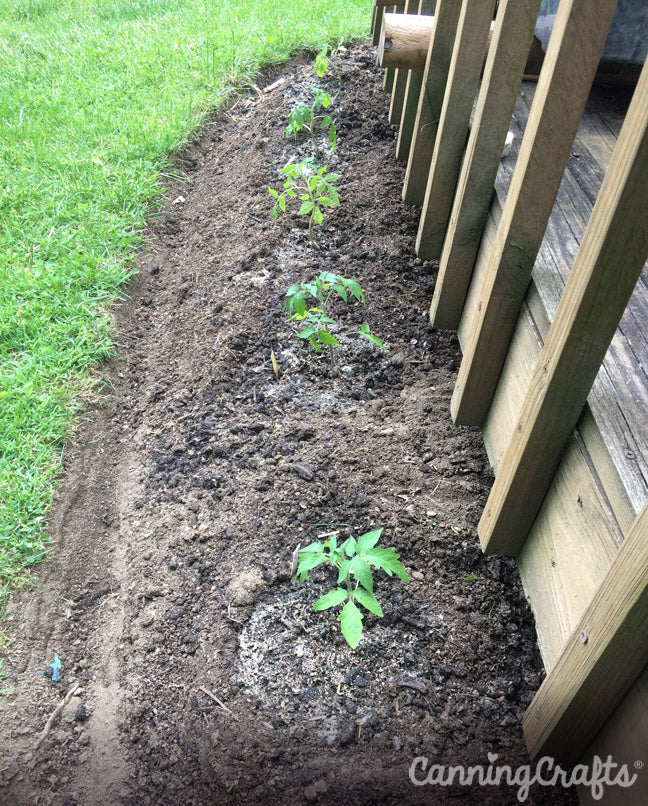Trench Planting Tomatoes for Epic Root Growth & Strong Plants
04. May 2022Let me run a couple spring gardening scenarios past you. A) You’ve waited too darn long to get your tomato seedlings into the ground, and your once oh-so-adorable tomato babies are now tall enough to play for the L.A. Lakers. B) You’ve waited way too long to pick up your tomato plants from the garden center, and all they have left are things that look like a cross between Groot and Stephen King from Creepshow. Many of us gardeners have been in similar predicaments to these. The plant is so overly gangly and huge and the root ball is easily nine inches or even root bound. So, what do you do? Dig a shallow grave and bury that sucker!

Or, more specifically, dig a long, trench about 6 inches deep. Then put that lanky or crooked thing horizontally on its side in the trench. Next, bury the stem, leaving the top of the tomato plant popping out of the soil. Easy-peasy. This is called trench planting and it is a heaven sent idea for folks with out of control ‘mater seedlings. Deep planting is a key to growing strong tomatoes.

This crooked ‘mater is a perfect candidate for trench planting. Once the bent stem is buried, the plant will grow up straight. Roots will form all along the buried stem to make the plant extra strong.
You may ask why plant your tomato in a trench instead of a deep hole? Great question! Most gardeners know to plant tomatoes deep in order to expand those precious roots and make the plant strong. So you can certainly dig a very deep hole instead of a long trench if desired. In fact, if I have a heathy and smaller tomato plant, I will often plant in a deep hole instead of a trench. But the benefit to trench planting TALL or CROOKED plants is that it should be less labor intensive. For really tall tomato plants, you would need to dig a super deep hole. In doing so, you may also run into more compacted soil, or clay soil, the deeper you dig. So you can save some time and physical effort by trench planting instead. But with either method, the end results will be the same: Strong tomato plants!
But how does it work? Have you ever looked at the stem of a tomato plant and noticed all those tiny little “hairs” covering it? Turns out those are roots just waiting to happen. So, once you submerge the stem in the soil, those minuscule guys kick in and start taking root. Combined with the existing root bulb of the plant, these new roots will absorb even more nutrients from the soil. This will then give your tomato plant much more strength and growth power!

So, trench planting is extremely easy to do with your overgrown tomato plants. First, dig a trench that is deep enough for the root ball. This will most likely be around 6 inches deep. You can make it slightly sloped, so that the roots are on the “deep” end. That way, the top of the plant will more easily slope out of the soil. Feel free to add some of the fertilizer of your choice, such as bonemeal, worm castings, or banana peels (see my informative banana tea fertilizer blog post to nurture your tomato babies). If you are planning to have stakes or trellises for your tomatoes, be sure to have them in place before you place the plants. You don’t want to accidentally stab your buried plant stem with a trellis as they are trying to grow. If you really want to grow incredibly productive tomatoes, also read my Japanese Rings trellis blog post for staking ideas.

Next, gently break or pinch off any lower branches and leafy growth. The plant will want to grow new branches to replace these, but since this portion will now be under the ground, it will instead create additional roots. Bonus roots! Score!!
Then lay your freshly pruned plants on their sides inside the trench. Cover over the root bulb and approximately the bottom third to one-half of the stem, leaving the remaining top portion uncovered. Admittedly, this will look strange having your plant sticking out a little crooked from the ground. If it has kinks or bends in the stem, don’t be too concerned. After a few days of sunshine and watering, it will start growing up straight toward the sky like it should.

Read our blog post:
Banana Peel Fertilizers for the Garden (great for tomatoes)

Add a banana peel directly to the hole when you plant tomatoes.

And speaking of plants, do you want more of them? That was rhetorical. Of course you do! As your tomato plants grow, you may have the urge to do a little maintenance and prune them. OR, you may find that an unfortunate event occurred and a few stems broke off. Either way, it’s a win because you can root those stems to grow more tomato plants! It’s tremendously easy to do so even. In fact, many old-timey gardeners would only grow or purchase a few plants at the beginning of the season. Then they would propagate many additional plants from the original plant’s clippings. Not only is it economical, you will get full sized plants faster than starting from seed. Plus, this can also be a good way to succession plant tomatoes so you can extend your harvest for the season. Rooting a few extra plant clippings will allow you to quickly replace anything damaged by varmints or mother nature as well.

Be sure to read our other blog posts on tomatoes to increase your yield in the garden (and the kitchen).
Grow Prolific Tomatoes Using Japanese Rings Staking Method
Banana Peel Fertilizers for the Garden (great for tomatoes)
How to Save Tomato Seeds
Tomato Canning Recipes
Read all of our Tomato Blog Posts
If you're looking for more tomato growing tips and recipes, follow our Pinterest Tomato Board.











